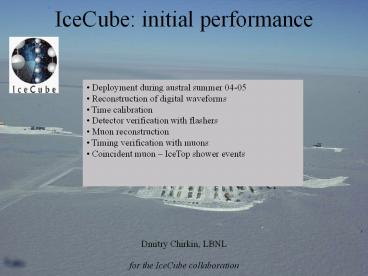IceCube: initial performance PowerPoint PPT Presentation
Title: IceCube: initial performance
1
IceCube initial performance
- Deployment during austral summer 04-05
- Reconstruction of digital waveforms
- Time calibration
- Detector verification with flashers
- Muon reconstruction
- Timing verification with muons
- Coincident muon IceTop shower events
Dmitry Chirkin, LBNL
for the IceCube collaboration
2
IceCube introduction
- Deep ice array IceCube
- Digital readout technology
- 80 strings / 60 DOMs each
- 17 m DOM spacing
- 125 m between strings
- hexagonal pattern over 1 km2x1 km
3
The first muon IceTop shower coincident event
January 23 First runs with the four IceTop
stations (8 tanks) taken January 29 131 NZT
First IceCube string deployed February 9 First
shower/muon coincidence events found
4
Waveform pulse reconstruction
5
Time Calibration
6
Timing verification with flashers
7
IceCube muon data reconstruction
8
Muon time calibration verification
- reconstruct muon tracks without DOM X
- plot the time residual for DOM X for nearby
reconstructed tracks - if scattering length is longer than the distance
cut (10 m) the most likely residual should be 0,
otherwise residual will show delay increasing
with the amount of scattering.
9
IceTop and in-ice coincidences
10
Summary
- The first IceCube string and four IceTop
stations were deployed last austral summer
analysis began after freeze-in. - The ability to reconstruct muons and air
showers, and to detect muons coincident with air
showers was demonstrated - The observed muon flux is consistent with the
expectation from the simulation - The overall detector timing uncertainty was
measured to be below 3 ns - The first elements of the IceCube detector
perform as expected, or better. - Deployment of up to 10 IceCube strings and 20
IceTop tanks is scheduled for the coming season.
11
Reconstruction of the simulated data
PowerShow.com is a leading presentation sharing website. It has millions of presentations already uploaded and available with 1,000s more being uploaded by its users every day. Whatever your area of interest, here you’ll be able to find and view presentations you’ll love and possibly download. And, best of all, it is completely free and easy to use.
You might even have a presentation you’d like to share with others. If so, just upload it to PowerShow.com. We’ll convert it to an HTML5 slideshow that includes all the media types you’ve already added: audio, video, music, pictures, animations and transition effects. Then you can share it with your target audience as well as PowerShow.com’s millions of monthly visitors. And, again, it’s all free.
About the Developers
PowerShow.com is brought to you by CrystalGraphics, the award-winning developer and market-leading publisher of rich-media enhancement products for presentations. Our product offerings include millions of PowerPoint templates, diagrams, animated 3D characters and more.

